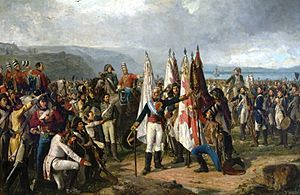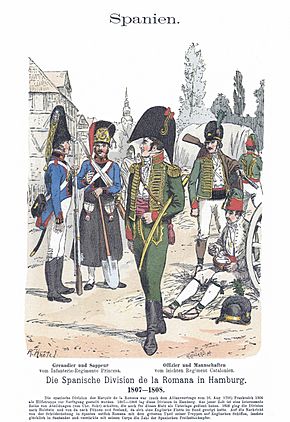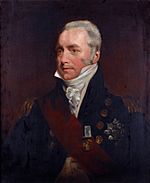Evacuation of La Romana's division facts for kids
Quick facts for kids Evacuation of La Romana's division |
|||||||
|---|---|---|---|---|---|---|---|
| Part of the Peninsular War | |||||||
 El juramento de las tropas del Marqués de la Romana, by Manuel Castellano |
|||||||
|
|||||||
| Belligerents | |||||||
| Commanders and leaders | |||||||
|
|
|
||||||
| Strength | |||||||
| 30,000 | 13,500 | ||||||
| Casualties and losses | |||||||
| None | 4,500 captured | ||||||
The evacuation of La Romana's division in August 1808 was a daring military rescue. A group of Spanish soldiers, led by Marquis of La Romana, were serving far from home in Denmark. They were part of Napoleon's army. But when Napoleon took over Spain, these soldiers decided they wanted to fight for their own country. The British navy helped them escape from Denmark and sail back to Spain. There, they could join the fight against France in the Peninsular War.
In 1807, these Spanish troops, called the Division of the North, were sent to northern Europe. They were supposed to help France and Denmark invade Sweden. However, in 1808, the Spanish officers and soldiers learned shocking news. Emperor Napoleon had removed their king, Charles IV of Spain, and his son, Ferdinand, from the Spanish throne. Instead, Napoleon put his own brother, Joseph Bonaparte, in charge of Spain.
The British government found out that General La Romana wanted to escape Denmark. So, they sent a secret agent to talk to him. On July 23, 1808, the British navy sent secret orders to Commodore Richard Goodwin Keats. He was told to help the Spanish commander evacuate his troops. Keats and La Romana secretly planned for the Spanish soldiers to gather at Nyborg. From there, the British fleet would pick them up.
Keats sailed his ships into the harbor and took about 57 boats. He used these boats to move the Spanish troops to nearby Langeland island. They waited there for more supplies and ships from England. Sadly, one cavalry and two infantry regiments couldn't escape and remained under Napoleon's control. But in August 1808, most of the Spanish units successfully met up with the British navy.
The Spanish troops were worried about the French army coming from the west. Also, the promised transport ships hadn't arrived yet. So, the soldiers got back on the ships they had. The convoy then sailed to Gothenburg in Sweden. On September 6, the larger transport ships finally arrived. After a stormy three-week journey, about 9,000 Spanish soldiers landed in Santander, Spain, in October 1808. They were finally ready to fight against the French.
Contents
Why the Spanish Troops Were in Denmark
In 1806, Spain was an ally of Emperor Napoleon. Their navies had even fought together against the British at the Battle of Trafalgar in 1805. At that time, Manuel de Godoy, Prince of the Peace was a very powerful figure in Spain. He was a favorite of King Charles IV of Spain.
When a new war started between Prussia and Napoleon, Godoy made a public statement. It seemed to be aimed at France, even though it didn't name them directly. After Napoleon won a big victory at the Battle of Jena-Auerstedt, Godoy quickly took back his statement. But it was too late. Napoleon already suspected that Spain might not be a loyal ally. From that moment on, Napoleon planned to deal with Spain later. For now, he forced Godoy and King Charles IV to send a group of Spanish soldiers to serve in northern Europe.
In March 1807, about 15,000 Spanish troops, known as La Romana's Division, headed to northern Europe. They included foot soldiers and cavalry. Their first stop was Hamburg. La Romana's Division fought under Marshal Guillaume Brune at the Siege of Stralsund. This siege ended in August 1807 when the Swedish army left the city.
The Spanish Division spent the winter of 1807–1808 in different parts of northern Europe. In early 1808, they marched into Denmark. Napoleon made sure the Spanish units were spread out. This made it hard for them to gather in one place. Danish troops were also always stationed nearby to watch them.
For example, 4,000 men were on the island of Zealand. Another 4,500 were on the island of Funen, where La Romana had his headquarters. Other troops were on Langeland and Jutland. To keep the soldiers happy, Napoleon increased their pay. He also promised La Romana a high honor.
However, French officials started to stop messages between La Romana and the Spanish government. But one Spanish officer managed to get through in April. He brought news that 15 messages from Spain had gone unanswered. Finally, La Romana and his officers learned that the French had taken over Spanish cities like Barcelona in March. Soon after, they heard about the Dos de Mayo Uprising in Spain. Most of the Spanish soldiers were furious. But they realized they were surrounded by enemies and far from home. On June 24, La Romana learned that Joseph Bonaparte had been declared king of Spain. This made the Spanish soldiers even more determined to escape.
The Secret Plan to Escape
After the Peninsular War began, the British government wanted to contact the Spanish troops in Denmark. They wanted to know if these soldiers would fight against Napoleon. The British navy controlled the Baltic Sea, so they could pick up the Spaniards if they could reach the coast. But first, an agent had to get past Napoleon's secret police to reach La Romana.
Luckily, Sir Arthur Wellesley had suggested a good person for this job. This was James Robertson, a Roman Catholic priest from Scotland. Robertson agreed to the mission. He traveled into Denmark pretending to be a German merchant selling chocolate and cigars.
Robertson found La Romana in Nyborg. At first, La Romana thought Robertson might be a French spy trying to test him. But the priest eventually convinced La Romana that he was working for the British. La Romana admitted he was upset by his situation and knew Napoleon's plans for Spain were bad.
The Scottish priest then explained the plan: the British navy would evacuate the Spanish troops from Denmark. They could take them to any part of the Spanish empire La Romana wanted. After talking with his officers, La Romana agreed to the plan. The plan almost failed when Robertson was caught by a Danish patrol. He managed to talk his way out, but it's not clear if he got his message to a British warship.
On July 23, 1808, the British Admiralty sent a Spanish agent named Lobo with secret instructions. He sailed on the fast ship Musquito to Commodore Keats. Keats was told to talk to the Spanish commander about evacuating his army. Lobo arrived on Keats's ship HMS Superb on August 5. With help from another Spanish officer who had escaped, they created a plan. Keats would use his ships to safely move and feed about 10,000 men. The plan was to temporarily camp on Langeland island. This island could provide food and be defended until more ships arrived from England.
The Great Escape
La Romana told only a few trusted officers about the secret plan. The first idea was to gather all Spanish troops for a big review by Marshal Bernadotte. This would allow them to be in one place. But this plan didn't happen. Orders came from France that all Spanish soldiers had to swear loyalty to King Joseph Bonaparte. The troops on Jutland and Funen took the oath. Their officers pretended not to notice when the soldiers swore loyalty to Prince Ferdinand instead of Joseph.
However, on July 31, there was a full-scale mutiny on Zealand. A French general's aide was killed. The next day, the Asturias and Guadalajara Regiments were surrounded by many Danish troops and forced to surrender. These soldiers were then held in small groups.
This incident worried Bernadotte. But before he could do more, La Romana heard that the Spanish agent, Rafael Lobo, had arrived offshore. Lobo said the British fleet was on its way. So, La Romana sent word to his officers: it was time to act.
On August 7, the Spanish troops on Funen took control of the port of Nyborg. The only resistance came from two Danish ships in the harbor. Boats from HMS Edgar attacked and captured them. The next day, soldiers on Jutland took some small boats at Fredericia and Aarhus and sailed to Funen. The Infante, Rey, and Zamora Regiments successfully escaped. However, the colonel of the Algarve regiment refused to move. Finally, the senior captain started the plan, but it was too late for that regiment. A French general found out about the plot.
By this time, La Romana had gathered 8,000 Spanish soldiers on Funen. The Danish troops nearby did not attack La Romana's force. Keats took about 57 small boats from Nyborg harbor and put the Spanish troops on them. As they sailed into open waters, they were joined by boats carrying regiments from Aarhus. These were protected by the British ship Snipe. Between August 9 and 11, the troops on Funen sailed to Langeland. There, the 1st of Catalonia regiment had already defeated the Danish soldiers.
La Romana's 9,000 Spanish troops waited at Langeland until August 21. By then, they could hear gunfire as the French army advanced from the west. It was no longer safe to wait for the promised transport ships. So, Keats ordered the troops to get back on the ships he had, including the small boats from Nyborg and others he had taken from passing convoys. By August 23, the convoy was sailing to Gothenburg, Sweden. Soon after, they met supply ships sent from England.
Eventually, the promised convoy of about 35 transport ships arrived. On September 9, the troops boarded these ships for the journey home. The fleet sailed to Santander, where they dropped off La Romana's troops by October 11. The foot soldiers immediately got ready to fight. The cavalrymen marched to Extremadura to get horses.
What Happened Next
When the troops arrived in Santander, La Romana organized the infantry into the 5th Division of the Army of Galicia. This division was ordered to join Joaquín Blake's army. However, only the 1st of Catalonia regiment, with 1,066 men, arrived in time for the Battle of Zornoza on October 31, 1808. The 5th Division protected the army's rear during the retreat that followed. The French chased them so closely that Blake decided to fight on November 10. In the two-day Battle of Espinosa de los Monteros, the 5th Division fought off several French attacks on the first day. They lost about 1,000 men. A month later, the 5th Division still had nearly 4,000 soldiers.
The Spanish soldiers who were not successfully evacuated from Denmark ended up fighting for Napoleon. Many were forced to join the French invasion of Russia and fought at the Battle of Borodino in 1812. As many as 4,000 Spanish soldiers were captured during the retreat from Russia. They were then handed over to the British Royal Navy and sent back to Spain.
Commodore Keats was highly praised for how he managed this complex rescue. Saving the troops was seen as important as winning a battle. It showed Britain's enemies that their navy could successfully carry out important missions and move many troops where needed. Keats received an award and took the motto of La Romana's regiment, "Mi Patria Es Mi Norte" (My Homeland Is My North), as his own.
See also






